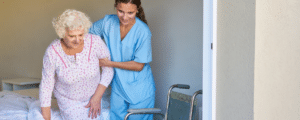Bedsores are a significant concern among older adults and individuals with mobility problems. They occur when a person spends too much time in one position, causing skin irritation—especially in areas where thinner skin covers bone, such as the heels, shoulder blades, and ankles.
Stages of bedsores are sometimes broken down into four categories, with level four bedsores posing the most severe risks to an individual’s health. On this page, we explain how to recognize and prevent bedsores at each stage.
Brown & Crouppen is a leading personal injury law firm in Missouri. Call (800) 536-4357 or contact us online to learn more about your options if your loved one is struggling with bedsores caused by neglect. Our skilled legal team can help you seek justice and compensation through a Missouri bedsore lawsuit.
What Are Bedsores?
Bedsores, also known as pressure ulcers or decubitus ulcers, are injuries to the skin and underlying tissue resulting from prolonged pressure on the skin. They commonly develop in areas where the body’s weight rests against a surface, such as the back, buttocks, hips, heels, and elbows. Constant pressure reduces blood flow to the affected area, leading to tissue damage and eventual ulcer formation.
Nursing home facilities, in particular, must take special care to prevent bedsores among their patients. Frequent turning and repositioning of bedridden and immobile patients can help. It’s also vital to ensure elderly patients receive adequate nutrition and maintain good hygiene.
Causes of Bedsores
Bedsores can develop due to various factors. Most are related to prolonged pressure on the skin and underlying tissues. Common causes of bedsores include:
- Immobility – People who are bedridden or have limited mobility are at a higher risk of developing bedsores because they may remain in one position for extended periods without shifting their weight.
- Pressure – Continuous pressure on certain parts of the body, such as the back, buttocks, hips, heels, and elbows, can lead to reduced blood flow to those areas, leading to tissue damage.
- Friction and shear – Friction occurs when the skin rubs against another surface, while shear happens when layers of skin are pulled in opposite directions. Both friction and shear can contribute to skin breakdown and increase the risk of bedsores.
- Moisture – Excessive moisture from sweat, urine, or feces can soften the skin, making it more susceptible to damage. Moist skin is also more prone to friction and irritation, further increasing the risk of bedsores.
- Poor nutrition and hydration – Malnutrition and dehydration can weaken the skin and impair its ability to heal, making individuals more susceptible to bedsores.
- Reduced sensation – Conditions such as diabetes or spinal cord injuries can impair sensation, making individuals less aware of discomfort or pressure on their skin, which can lead to delayed detection and treatment of bedsores.
- Medical conditions – Certain medical conditions, such as vascular disease, diabetes, or neurological disorders, can compromise blood flow and skin integrity, increasing the risk of bedsores.
Stages of Bedsores?
Doctors rate the severity of bedsores into four stages:
Stage 1 Bedsores
Stage 1 bedsores are the least severe and easiest to treat. Catching bedsores early, when symptoms first appear, can result in optimal patient recovery.
| Stage 1 Bedsore | |
| Symptoms |
|
| Stage 1 Bedsore Treatment |
Initial treatment for bedsores involves removing pressure from the area to prevent it from worsening or tearing the skin’s surface. You may provide the patient with additional pillows, padding, or blankets to reduce pressure. Providers must ensure the bedsore remains clean and dry and that the patient receives adequate nutrition. Foods high in calcium, protein, and iron can improve skin health and protect against further damage. |
| Stage 1 Bedsore Life Expectancy |
A stage 1 bedsore typically heals within three days. |
Stage 2 Bedsores
In a Stage 2 bedsore, there is a small break in the skin, which may be superficial or penetrate the epidermis.
| Stage 2 Bedsore | |
| Symptoms |
|
| Stage 2 Bedsore Treatment |
As with a Stage 1 bedsore, start by removing pressure on the wound. Seek medical attention from a qualified practitioner. The bedsore will require special dressings and gauze to prevent it from worsening. Caretakers must also keep the area clean and bandaged, monitoring it for signs of infection like pus, redness, and fever. |
| Stage 2 Bedsore Life Expectancy |
Recovery times for a Stage 2 bedsore range from three days to three weeks. |
Stage 3 Bedsores
A Stage 3 bedsore may take on a crater-like appearance. It will break through the top layers of skin and into the fatty tissue.
| Stage 3 Bedsore | |
| Symptoms |
|
| Stage 3 Bedsore Treatment |
Treating a Stage 3 bedsore starts with an immediate, comprehensive medical evaluation. A doctor should evaluate the bedsore’s severity and recommend a treatment plan. Some treatment options include antibiotics and surgical removal of dead tissue, as well as customized bedding and pressure-relieving mattresses to assist with recovery. |
| Stage 3 Bedsore Life Expectancy |
Recovery times for a Stage 3 bedsore range from one to four months. |
Stage 4 Bedsores
A Stage 4 bedsore is the most dangerous. If not treated effectively, they may be life-threatening.
| Stage 4 Bedsore | |
| Symptoms |
|
| Stage 4 Bedsore Treatment |
Treating a Stage 4 bedsore requires immediate hospital evaluation. The bedsore will likely require surgery, but other treatment options can include skin grafts and antibiotics. |
| Stage 4 Bedsore Life Expectancy |
Recovery times for a Stage 4 bedsore range from three months to two years. |
Bedsore Life Expectancy
Once a caregiver or patient notices a bedsore, seeking treatment immediately is crucial. The longer the bedsore remains untreated, the more likely it is to increase in severity. Patients with an early-stage pressure sore may recover with appropriate treatment within two to three weeks.
However, once a Stage 3 or 4 bedsore develops, the risk of life-threatening complications increases. According to one study involving over 70 patients, “A 180-day mortality rate of 68.9 percent was noted in people who developed . . . full-thickness pressure ulcers, with an average of 47 days from ulcer onset to death.”
Ways to Prevent Bedsores
Preventing bedsores involves a combination of strategies to reduce pressure on the skin, maintain skin integrity, and promote overall health. Here are some key prevention measures:
- Regular repositioning – Change positions frequently to relieve pressure on specific body areas. Repositioning every 2 hours is often recommended.
- Regular skincare – Keep the skin clean, dry, and well-moisturized to prevent irritation and breakdown. Use gentle cleansing techniques and avoid harsh soaps or alcohol-based products that can dry out the skin.
- Proper nutrition and hydration – Ensure adequate intake of nutrients to support skin health and healing. Stay hydrated by drinking plenty of fluids, as dehydration can increase the risk of skin damage.
- Regular assessment – Conduct regular skin assessments to identify early signs of pressure ulcers, such as redness, warmth, or changes in skin texture. Promptly address symptoms with appropriate intervention.
- Mobilization and activity – Encourage mobility and physical activity to improve circulation, muscle strength, and overall well-being. Even simple exercises or range-of-motion activities can help reduce the risk of bedsores.
- Pressure relief devices – Consider using specialized devices such as heel protectors, elbow pads, pressure-reducing mattresses, and seat cushions to provide additional pressure relief for vulnerable areas.
- Collaborative care – Doctors, nurses, therapists, dietitians, and wound care specialists can develop an individualized prevention plan tailored to the patient’s needs and risk factors.
What to Do If A Loved One Suffers Bedsores at a Nursing Home Facility
All nursing home facilities must ensure adequate patient care, and bedsores can indicate potential neglect. If you find evidence of bedsores, immediately seek medical attention. Further, if your loved one develops a bedsore while in a nursing home, you may have legal grounds to pursue a bedsore lawsuit.
Brown & Crouppen is dedicated to serving our community by helping injury victims exercise their right to justice and compensation. Our skilled legal team is standing by to hold negligent nursing homes accountable for your loved one’s bedsores.
Our award-winning law firm has secured millions of dollars in settlements and verdicts for our clients, including a $500,000 wrongful death settlement for a client whose mother died due to Stage 4 bedsores. Do not wait to take legal action. Call (800) 536-4357 or contact us online to learn more in your free consultation.
Sources:
- Al Aboud, A., Manna, B. (2023, April 19). Wound Pressure Injury Management. National Library of Medicine. https://www.ncbi.nlm.nih.gov/books/NBK532897/
- Brown, G. (2003, October). Long-term outcomes of full-thickness pressure ulcers: healing and mortality. National Library of Medicine. https://pubmed.ncbi.nlm.nih.gov/14652420/
- Bedsores. (2021, August 8). Johns Hopkins Medicine. https://www.hopkinsmedicine.org/health/conditions-and-diseases/bedsores







